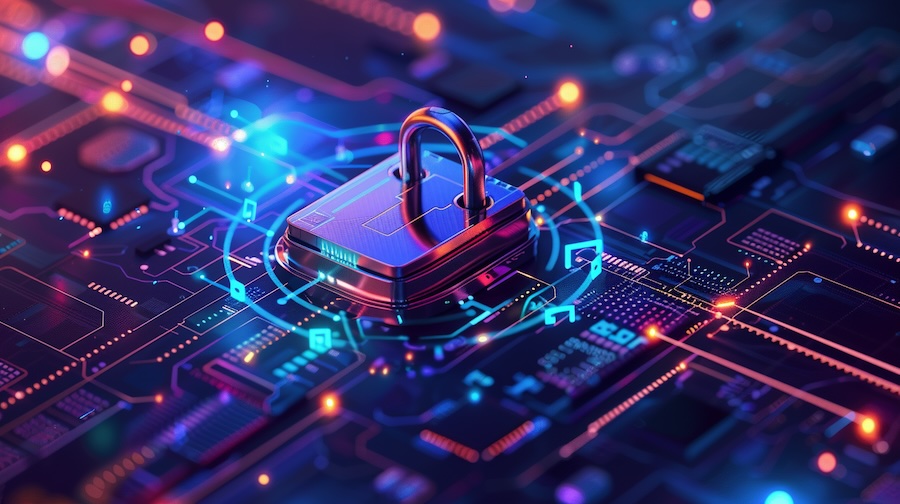We created this blog post for the EU-funded project “V2B: Creating NFT Opportunities on Metaverse for Art VET Trainees”, and our project reference number is 2022-1-DE02-KA210-VET-000080828. Coordinated by L4Y Learning for Youth GmbH in collaboration with Adana Cukurova Guzel Sanatlar and EMC Services Ltd, “Digital Asset Security Strategies” is prepared related to the training framework in the introduction post.
In this article, our focus key phrase revolves around “Digital Asset Security Strategies.” We recognize the significance of digital identity and digital assets, delving into the concept of digital identity, its historical context, and its defining features. Additionally, we define digital assets, explore their history and unique attributes, and address the prevalent threats within the digital realm. Our primary aim is to elaborate on effective precautions and strategies, offering insights into safeguarding these assets against potential risks.
By emphasising the need to protect our digital identities and assets, we will explain what kind of threats we may face. We will discuss not only against whom we need to protect our identity and assets, but also the methods by which they can be realised. In particular, we will discuss the advantages and potential risks offered by blockchain technology, and we will discuss how to provide a more secure digital asset management by using this technology.
The target audience of this article includes everyone who uses the internet and owns digital assets. Finally, our aim is to help our readers gain awareness about the security of their digital identity and assets and to help them take the necessary steps in this regard.
Learning Objectives
By the end of this module, learners should be able to:
- Define what a Digital Identity is and describe its history and characteristics.
- Explain the term “Digital Asset” and identify its historical context and key characteristics.
- Identify the essential features that are used to create a Digital Identity.
- List and describe the major types of threats to Digital Assets and Identity
- Identify common threats specific to Blockchain assets
- Describe defense techniques that can be developed to secure assets and identity on Blockchain technology.
What Is Digital Identity? What Is Its History And Characteristics?
A digital identity enables a person or organization to be identified in the digital environment. Digital identities are an electronic identification process that helps people identify who they are in the digital world.
A digital identity constitutes a comprehensive digital representation, comprising various identities held by individuals or organizations. People frequently encounter the concept of digital identity, which is one of the most fashionable concepts today.
With increasing digitalization, there is a need for real-life identities to go digital. The history of digital identities goes back 30 years. It has been used since the birth of the modern internet, i.e., since 30 years ago. However, with the increasing digitalization of real-world transactions, interest in them has also increased. Although there is not yet a standard definition of a digital ID, almost all definitions are based on the following basic concepts:
Digital Asset Security Strategies: Digital ID definition
Digital identity or ID refers to the online representation and documentation of an individual.
Each digital ID associated with a unique individual is a collection of verified and stored attributes.
Furthermore, digitised IDs respond to identification when accessing online services or to the identity request of any digital transaction.
Just like in the real world, digital IDs have a set of universal rules:
Firstly, a digital ID must be personal and non-transferable.
Secondly, access and usage rights should only belong to the person to whom it belongs.
Moreover, the digital ID must be reusable. In short, it should be possible to use the same digital ID whenever needed.
Additionally, the use of a digital ID should be accessible at all times without requiring any technical expertise.
Finally, digital IDs must be able to execute certain actions and fulfil objectives.
Digital Asset Security Strategies: Identifying Features For Creating A Digital Identity
Firstly, name, date of birth and other personal information
Secondly, login credentials for access to certain online services
Additionally, e-mail addresses
Furthermore, passport numbers
Moreover, social Security numbers
Browser movements and online search activities
Lastly, online shopping and related activities
Digital Asset Security Strategies: What Is A Digital Asset? What Is Its History And Characteristics?
A digital asset serves as a type of identity, enabling a person or organization to be identifiable in the digital environment. Digital assets are trading instruments created, stored, and transferred electronically. The history of digital assets goes back to 30 years ago. It has been used since the birth of the modern internet, that is, for 30 years. The use of digital assets in different sectors has started to increase. The main features of digital assets are as follows:
-Digital assets exist in digital form and have no equivalent in physical form.
-Producers create and use digital assets more cost-effectively, eliminating the need for physical production.
-Digital assets can exist in both decentralised and centralised forms.
-Their transfers are faster. They are also easier to transfer internationally.
You can transfer the value of digital assets.
Digital Asset Security Strategies: What Are The Possible Threats To Our Digital Assets And Identity?
Possible threats to your digital assets and identity may include:
Phishing
This involves an attacker stealing your personal information using a fake website or email.
Phishing attacks occur when someone tries to trick you into sharing personal information. Phishers usually conduct their activities through emails, adverts, or sites resembling those you already use. For example, you may receive an email that appears to be from your bank asking you to confirm your bank account number. Information phishing sites may ask for includes usernames, passwords, ID or insurance numbers, bank account numbers, PINs (Personal Identification Numbers), credit card numbers, your mother’s maiden name and your birthday.
Malware, which poses a serious threat to digital security, entails the installation of malicious software on your computer by an attacker. Once installed, this software is capable of illicitly accessing and stealing the data stored on your device, or even gaining control over your system. The malevolent intentions behind malware manifest in various ways. It can encompass data theft, device manipulation, and overall device performance disruption. Within the realm of malicious software, a variety of forms exist, including viruses, worms, Trojans, and spyware. Viruses, being one such form, propagate through self-replication, much like worms which share a similar modus operandi.
Social Engineering
This involves an attacker manipulating you to persuade you to disclose personal information. For instance:
An attacker may call a bank’s customer service number and identify themselves as the bank’s customer service representative, attempting to convince you to share personal information.
On the other hand, an attacker may send an email, portraying themselves as a close friend or family member, and cunningly request money from you.
Once more, a deceptive attacker might create a website, masquerading as a legitimate organization, and then coax you into divulging personal information or credit card details.
Password Cracking
This involves an attacker breaking your password to access your account.
Examples of this particular type of attack encompass a range of malicious methodologies, each with its own distinct characteristics. For instance, notable instances include brute force attacks, where attackers systematically attempt every possible password combination to gain unauthorized access. Additionally, password spraying attacks involve trying a few common passwords across many accounts. Furthermore, hash crack attacks aim to decipher hashed versions of passwords. Lastly, rainbow table attacks use precomputed tables to crack password hashes. Each method showcases a unique approach to breaching security.
Similarly, password spraying attacks involve trying multiple accounts using widely-used, common passwords. Hash crack attacks focus on decoding the hash values of passwords in order to unveil the actual passwords. On the other hand, rainbow table attacks operate by leveraging a pre-calculated list of hash values, seeking to deduce your password through this method. These instances shed light on the diverse tactics malevolent actors employ to compromise digital security.
Network Attacks
This involves an attacker directly attacking your network or device.
Network attacks involve deliberate and damaging actions carried out on computer systems, network infrastructures, or devices connected to the internet, and various entities, including hackers, cybercriminals, state-sponsored actors, or malicious individuals, can execute these attacks.
Network attacks can lead to an array of harmful consequences, including information theft, system disabling, data manipulation, service interruption, and violation of user privacy. Examples of network attacks encompass the following:
DDoS (Distributed Denial of Service) Attacks: It consumes network resources and creates service interruption by directing traffic from multiple sources to the target system.
Man-in-the-Middle (MitM) Attacks: It intervenes between two parties involved in communication and intercepts, manipulates or monitors data.
ARP (Address Resolution Protocol) Poisoning Attacks: Interrupts or redirects the communication of the target device by manipulating the ARP table in the network.
Rogue AP (Rogue Access Point) Attacks: Captures or manipulates users’ network traffic by creating an artificial access point.
VLAN Hopping Attacks: Aims to bypass firewalls by passing VLAN traffic in virtual networks without authorisation.
Botnet Attacks: It attacks target systems or performs malicious operations with a bot network consisting of many computers.
Physical Theft
This involves an attacker stealing your devices or other digital assets.
Digital Asset Security Strategies: What Are The Defence Techniques That Can Be Developed Against These Threats?
Possible threats to your digital assets and identity and defence techniques that can be developed against them include:
Phishing
This involves an attacker stealing your personal information using a fake website or email. To protect against this type of attack, read emails carefully and do not click on links from unknown sources. Also, protect your accounts by using strong passwords and use two-factor authentication.
By creating strong passwords, you can prevent others from accessing your account. The safest and easiest way to create strong passwords is to let Chrome suggest passwords for you. If you want to create your own password, consider these points:
Digital Asset Security Strategies: To Create Your Own Password…
Employing a unique password for each account is of paramount importance. This precaution is essential because reusing passwords can lead to significant risks. In the unfortunate event that an unauthorized individual gains possession of the password for just one of your accounts, they can exploit it to seize control of not only your email but also your social media profiles or even your financial accounts. To effectively counter this looming threat, experts strongly advise adopting the practice of using distinct passwords across all your accounts.
For enhanced password management, acquiring the skills to securely store, organize, and shield your passwords is crucial. By acquainting yourself with these techniques, you can streamline the process of managing your passwords more effectively.
Use long and memorable passwords. Long passwords are stronger than short passwords. Your password should be at least 12 characters long. Do not use information in your password that someone else knows or can easily find. Avoid simple words, common phrases, and easily recognisable patterns.
Malicious Software
This involves an attacker installing malicious software on your computer, and to safeguard your device against such attacks, it’s crucial to use antivirus software and regularly update your software.
Social Engineering
This involves an attacker manipulating you to convince you to disclose your personal information, and to counteract this type of attack, it’s important to carefully read emails from unknown sources and refrain from opening messages that appear suspicious.
Password Cracking
This involves an attacker accessing your account by cracking your password, so to defend against this type of attack, it’s crucial to protect your accounts by using strong passwords and implementing two-factor authentication.
Network Attacks
This involves an attacker directly attacking your network or device, and to guard against this type of attack, it’s essential to protect your devices by using a secure network and implementing firewalls on your network.
Physical Theft
This involves an attacker stealing your devices or other digital assets, so it’s crucial to take physical security measures against this type of attack to keep your devices safe.
Digital Asset Security Strategies: Possible Threats To Blockchain Assets And Defence Techniques That Can Be Developed
As blockchain technology is decentralised, it carries some security risks. Possible threats to blockchain assets could be the following:
51% attack
This means that an attacker must have more than 51% computing power to control transactions on the blockchain. As a result of this requirement, this type of attack can be utilized to manipulate transactions on the blockchain or to execute double-spending.
A 51% attack involves the alteration of the blockchain structure by gaining control of 51% or more of the total hash power of a given crypto asset. This particular attack form is viewed as a significant potential threat across numerous blockchain networks that rely on blockchain technologies. Such an attack has the capacity to commandeer a substantial number of miners on a blockchain network, thereby acquiring control over the network’s transactions. This, in turn, enables activities such as double spending or even precipitating a total network collapse. To guard against a 51% attack, defense techniques are crucial. These measures may encompass heightening the hash rate on the blockchain, closely monitoring transactions transpiring on the blockchain, and rigorously verifying the legitimacy of transactions on this platform.
DoS (Denial of Service) attack
This means that an attacker overloads the blockchain, slowing or stopping transactions.
A Denial of Service (DoS) attack, a type of cyber attack, occurs when an attacker disrupts computer systems or network resources, temporarily or permanently preventing user access. These attacks involve overwhelming the target system with excessive requests, depleting its network resources. The consequences can be severe, potentially rendering the system incapable of handling legitimate requests. To mitigate the impact of DoS attacks, various defense techniques have been developed, including increasing the blockchain’s hash rate, closely monitoring blockchain transactions, and thoroughly verifying blockchain transactions. Implementing these proactive measures can mitigate the adverse effects of DoS attacks, safeguarding the integrity of digital systems.
Sybil attack
This means that an attacker can create multiple accounts on the blockchain, allowing them to take control.
A Sybil attack is when an attacker on a computer network joins the network by creating multiple fake identities to mislead other users on the network. This type of attack can disrupt the functioning of the network and compromise the security of the network. Defence techniques against Sybil attacks can include increasing the hash rate on the blockchain, monitoring transactions on the blockchain, and verifying transactions on the blockchain
Digital Asset Security Strategies: Smart contract vulnerabilities
Smart contracts running on the blockchain may have some vulnerabilities, and these vulnerabilities can be exploited for malicious purposes.
These vulnerabilities, stemming from software bugs in smart contracts, are particularly concerning. They arise due to bugs in the code of smart contracts, which in turn can impact the proper functioning of these contracts. The vulnerabilities inherent in smart contracts can give rise to various types of attacks, each with the potential to compromise the integrity and functionality of these contracts.
In light of these vulnerabilities, implementing defense techniques becomes imperative. One such approach involves meticulously crafting and rigorously testing the code of smart contracts to ensure their correctness and robustness.
Malware
Malware can be used to manipulate or steal transactions on the blockchain.
Moreover, it can be exploited to manipulate or steal transactions on the blockchain. Recognizing the significance of malware’s impact on the blockchain becomes crucial for maintaining its security. The potential consequences of malware’s involvement in tampering with blockchain transactions are substantial. Such an attack has the capacity to not only disrupt the seamless functioning of the blockchain but also to compromise the accuracy and integrity of transactions conducted on this platform.
To counteract these threats, defense techniques tailored to blockchain technology are essential. These measures may encompass strategies like elevating the hash rate on the blockchain, closely monitoring transactions traversing the blockchain, and meticulously verifying the authenticity of transactions on this innovative platform.
Digital Asset Security Strategies: Defence techniques that can be developed for blockchain technology
Use strong passwords and change them regularly.
Use two-factor authentication whenever possible.
Keep your software up to date.
Use antivirus software and keep it up to date.
Be careful when opening email attachments or clicking on links from unknown sources.
Use a VPN when connecting to public Wi-Fi networks.
Be careful what you share on social media.
Regularly back up your data to an external hard drive or cloud storage service.
Monitor your accounts for suspicious activity.
Digital Asset Security Strategies: Conclusion
Throughout this article, we have extensively explored the definition, historical context, and evolution of digital identity and digital assets. Furthermore, we have delved into the potential threats associated with protecting our digital identity and assets. In response to these challenges, we have explored a variety of defense techniques that can be employed to effectively mitigate these threats.
Additionally, we’ve specifically outlined potential threats and defense mechanisms unique to the blockchain realm. Our ultimate aim is to heighten awareness among our target audience – comprising internet users and digital asset owners. Through this heightened awareness, we aspire to instigate behavioral changes that will empower individuals to navigate possible challenges adeptly. By imparting this knowledge, we hope to foster a proactive approach toward ensuring security within this ever-evolving digital landscape
Thank you!










